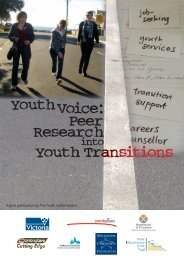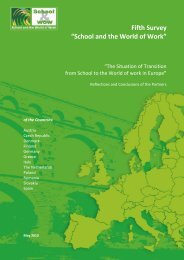Second Survey School and WOW.pdf
Second Survey School and WOW.pdf
Second Survey School and WOW.pdf
Create successful ePaper yourself
Turn your PDF publications into a flip-book with our unique Google optimized e-Paper software.
WORKING GROUP: TRANSITION<br />
1990: Israel, Turkey, Italy, Germany, Hungary<br />
1996‐2002: Italy, Spain, Israel, Turkey, Germany, Hungary, USA, Canada<br />
After 2002: Italy, Spain, Hungary, Germany<br />
Approximately 11% form the Romanian people aged 18‐59 year declares that they<br />
want to go working abroad in 2007 (1400000 people). (Source: Temporary<br />
Accommodation in a Foreign Country. Economic Migration of the Romanian People:<br />
1990‐2006. Foundation for an Open Society, 2006 www.osf.ro).<br />
Immigration<br />
<br />
2005: 49.485 foreigners were registered at the National Authority for Foreigners<br />
2006: 53.606 foreigners (8% more than in 2007)<br />
<br />
<br />
<br />
Foreign people represents 0,2% form the total Romanian population (21.7 mil.)‐ which<br />
is a low percent in comparison with the percent registered in another countries.<br />
The most of the immigrants are coming from: Moldavia, Turkey, China, Italy, Germany,<br />
SUA, Syria, France, Lebanon <strong>and</strong> Ukraine.<br />
Romanian active population: 9.7 mil. people. Foreign people working in Romania:<br />
0,58% representing form the total employed people, but the trend is that the number<br />
will increase.<br />
Estimation of the National Prognosis Commission: 2013‐2015, approximately 200.000 ‐<br />
300.000 foreigners will enter the Romanian labour market. (Source: Immigration <strong>and</strong><br />
Asylum in Romania‐ year 2006. Bucharest, 2007 www.mai.gov.ro)<br />
Slovakia<br />
Slovak economy has undergone many important changes in last 20 years <strong>and</strong> these have<br />
influenced our labour market crucially. Transition from centrally planned economy to market<br />
economy in 1989 meant unavoidable increase of before zero unemployment what brought<br />
new problems affecting almost every citizen directly or indirectly. Unemployment rate has<br />
increased rapidly (first increase in 1991, in 1994 unemployment rate was 14.38%).<br />
Private employers entering the labour market have decreased unemployment subsequently (in<br />
1998 ‐ 12.2%). The highest rate of unemployment (almost 20%) has been in 2001. From that<br />
year the rate of unemployment decreases constantly. This reduction has been supported also<br />
by EU entry of Slovak republic in 2004 <strong>and</strong> by accompanying increase of working mobility of<br />
Slovak citizens. Recent rate of unemployment is around 7,5% what is the one of highest rate in<br />
the EU. Unemployment is not distributed equally; western part of country has 2‐3% but<br />
eastern part 11‐13,5% of unemployment. A big problem is especially unemployment of young<br />
people under 25 (in November 2007 – 18,3%) <strong>and</strong> their share in long‐term unemployment that<br />
is still very high. Recently a new phenomenon has arisen on our labour market – despite the<br />
‐ 83 ‐




